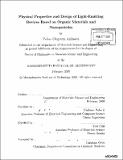Physical properties and design of light-emitting devices based on organic materials and nanoparticles
Author(s)
Anikeeva, Polina Olegovna
Downloadthesis PDF (76.06Mb)
Other Contributors
Massachusetts Institute of Technology. Dept. of Materials Science and Engineering.
Advisor
Vladimir Bulović and Yoel Fink.
Terms of use
Metadata
Show full item recordAbstract
This thesis presents the detailed experimental and theoretical characterization of light-emitting devices (LEDs) based on organic semiconductors and colloidal quantum dots (QDs). This hybrid material system has several advantages over crystalline semiconductor technology; first, it is compatible with inexpensive fabrication methods such as solution processing and roll-to-roll deposition; second, hybrid devices can be fabricated on flexible plastic substrates and glass, avoiding expensive crystalline wafers; third, this technology is compatible with patterning methods, allowing multicolor light sources to be fabricated on the same substrate by simply changing the emissive colloidal QD layer. While the fabrication methods for QD-LEDs have been extensively investigated, the basic physical processes governing the performance of QD-LEDs remained unclear. In this thesis we use electronic and optical measurements combined with morphological analysis to understand the origins of QD-LED operation. We investigate charge transport and exciton energy transfer between organic materials and colloidal QDs and use our findings as guidelines for the device design and material choices. We fabricate hybrid QD-LEDs with efficiencies exceeding those of previously reported devices by 50-300%. Novel deposition methods allow us to fabricate QD-LEDs of controlled and tunable color by simply changing the emissive QD layer without altering the structure of organic charge transport layers. For example, we fabricate white light sources with tunable color temperature and color rendering index close to that of sunlight, inaccessible by crystalline semiconductor based lighting or fluorescent sources. Our physical modeling of hybrid QD-LEDs provides insights on carrier transport and exciton generation in hybrid organic-QD devices that are in agreement with our experimental data. The general nature of our experimental and theoretical findings makes them applicable to a variety of hybrid organic-QD optoelectronic devices such as LEDs, solar cells, photodetectors and chemical sensors.
Date issued
2009Department
Massachusetts Institute of Technology. Department of Materials Science and EngineeringPublisher
Massachusetts Institute of Technology
Keywords
Materials Science and Engineering.